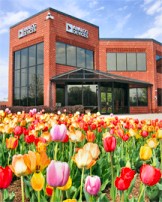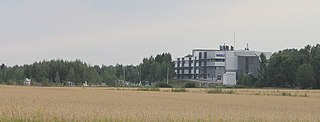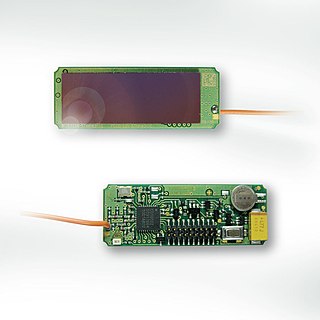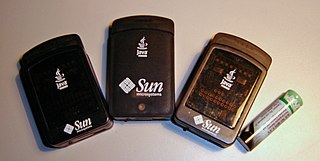Microtechnology is technology whose features have dimensions of the order of one micrometre. It focuses on physical and chemical processes as well as the production or manipulation of structures with one-micrometre magnitude.
Draper Laboratory is an American non-profit research and development organization, headquartered in Cambridge, Massachusetts; its official name is The Charles Stark Draper Laboratory, Inc. The laboratory specializes in the design, development, and deployment of advanced technology solutions to problems in national security, space exploration, health care and energy.

Infineon Technologies AG is Germany's largest semiconductor manufacturer. The company was spun-off from Siemens AG in 1999. Infineon has about 58,600 employees in 2023 and is one of the ten largest semiconductor manufacturers worldwide. In 2023 the company achieved sales of €16.309 billion.

Analog Devices, Inc. (ADI), also known simply as Analog, is an American multinational semiconductor company specializing in data conversion, signal processing, and power management technology, headquartered in Wilmington, Massachusetts.
Smartdust is a system of many tiny microelectromechanical systems (MEMS) such as sensors, robots, or other devices, that can detect, for example, light, temperature, vibration, magnetism, or chemicals. They are usually operated on a computer network wirelessly and are distributed over some area to perform tasks, usually sensing through radio-frequency identification. Without an antenna of much greater size the range of tiny smart dust communication devices is measured in a few millimeters and they may be vulnerable to electromagnetic disablement and destruction by microwave exposure.

Vaisala Oyj is a Finnish company that produces products and services for environmental and industrial measurement.

AeroVironment, Inc. is an American defense contractor headquartered in Arlington, Virginia, that designs and manufactures unmanned aerial vehicles (UAVs). Paul B. MacCready Jr., a designer of human-powered aircraft, founded the company in 1971. The company is best known for its lightweight human-powered and solar-powered vehicles. The company is the US military's top supplier of small drones —notably the Raven, Switchblade, Wasp and Puma models.

The EnOcean technology is an energy harvesting wireless technology used primarily in building automation systems, but also in other application fields such as industry, transportation, and logistics. The energy harvesting wireless modules are manufactured and marketed by the company EnOcean, headquartered in Oberhaching near Munich. The modules combine micro energy converters with ultra low power electronics and wireless communications and enable batteryless, wireless sensors, switches, and controls.

Microelectronics and Computer Technology Corporation, originally the Microelectronics and Computer Consortium and widely seen by the acronym MCC, was the first, and at one time one of the largest, computer industry research and development consortia in the United States. MCC ceased operations in 2000 and was formally dissolved in 2004.

Sun SPOT was a sensor node for a wireless sensor network developed by Sun Microsystems announced in 2007. The device used the IEEE 802.15.4 standard for its networking, and unlike other available sensor nodes, used the Squawk Java virtual machine.

SiRF Technology, Inc. was a pioneer in the commercial use of GPS technology for consumer applications. The company was founded in 1995 and was headquartered in San Jose, California. Notable and founding members included Sanjai Kohli, Dado Banatao, and Kanwar Chadha. The company was acquired by British firm CSR plc in 2009, who were in turn subsequently acquired by American company Qualcomm on 13 August 2015.

Mike A. Horton is an American engineer and founder of a company producing sensor technology and sensor-based systems.
Dust Networks, Inc. is an American company that specializes in the design and manufacture of wireless sensor networks for industrial applications including process monitoring, condition monitoring, asset management, environment, health and safety (EHS) monitoring, and power management. They were acquired by Linear Technology, Inc in December 2011, which in turn was acquired by Analog Devices, Inc. in 2017. The Dust Networks product team operates in the IoT Networking Platforms group of Analog Devices.

Greenwood Clean Energy, Inc. is a company located in Redmond, Washington that manufactures wood and biomass central heating systems. In 2009, a team of entrepreneurs and industry veterans developed and distributed woody-biomass-fueled heating appliances for home and light commercial use. In 2010, The Clean Energy Company, LLC (CEC) acquired the 'Greenwood' brand, certain assets and intellectual property of Greenwood Technologies. CEC also assumed the Greenwood name and became Greenwood Clean Energy, Inc. and began marketing its appliances under the 'Greenwood' brand. Greenwood Technologies, LLC ceased operations in February 2009. In 2012, Greenwood launched the Frontier Series indoor wood boiler, a 3rd generation wood gasification system.
SensorDynamics was a European semiconductor and MEMS company specialized in developing and manufacturing high-volume micro- and wireless semiconductor sensor products for applications in automotive, industry and high-end consumer sectors. The company was acquired by Maxim Integrated in 2011 for $164 million. SensorDynamics developed and produced custom-made designs and standard components for use in vehicle stabilization, occupant protection, navigation systems, keyless go systems and autonomous energy generators for wireless and battery free controllers for industrial, automotive and high-end consumer application. With its headquarters in Graz, Austria, SensorDynamics had offices in Italy and Germany and a worldwide sales and distribution network. The company employed about 130 people in 2011.
Sumitomo Precision Products Co., Ltd. is an integrated manufacturer of aerospace equipment, heat exchangers, hydraulic controls, wireless sensor networks, sensors, micro-electronics technology, and environmental systems. The aerospace division supplies its products to aerospace industries worldwide, including Boeing, Airbus, Bombardier, and Embraer.
Kionix, Inc. is a manufacturer of MEMS inertial sensors. Headquartered in Ithaca, New York, United States, the company is a wholly owned subsidiary of ROHM Co., Ltd. of Japan. Kionix developed high-aspect-ratio silicon micromachining based on research originally conducted at Cornell University. The company offers inertial sensors, and development tools and application support to enable motion-based gaming; user-interface functionality in mobile handsets, personal navigation and TV remote controllers; and hard-disk-drive drop protection in mobile products. The company's MEMS products are also used in the automotive, industrial and health-care sectors. Kionix is ISO 9001:2008 and TS16949 registered.

CEA-Leti is a research institute for electronics and information technologies, based in Grenoble, France. It is one of the world's largest organizations for applied research in microelectronics and nanotechnology. It is located within the CEA Grenoble center of the French Alternative Energies and Atomic Energy Commission (CEA).

ecobee is a Canadian founded home automation company that makes smart thermostats, temperature, and occupancy sensors, smart light switches, smart cameras, and contact sensors. They were acquired by the American company Generac Holdings in 2021.












